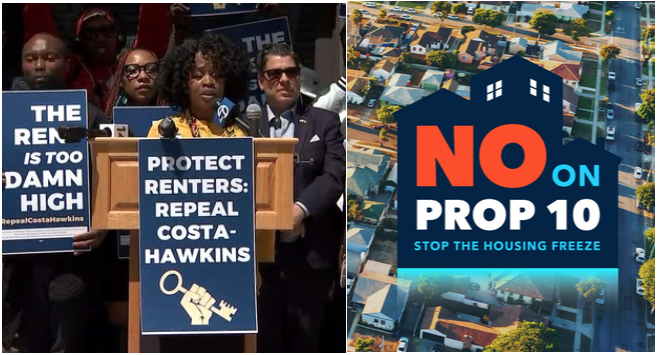CommentsDEEGAN ON LA-“Distortion,” fueled by the big spending of special interests in the political campaign to fight against Prop 10 on the November 6 ballot, joins “disruption” as another political buzzword this election cycle.
“Community roots” may be the operative term on the other side, a reflection of the plight of tenants who want to remain in affordable housing with rent control so they can continue living in their longtime neighborhoods. If Prop 10 passes, which side will be hurt more by the introduction of a new eligibility for rent control? This may represent the yin and yang of this proposition on the November 6 ballot. For every positive response to Prop 10, there's a corresponding negative reaction. Emotion and distortion seem to rule over facts and reason in the controversy.
Will the stability of a two-tier rental market be upset by adding rent control protections to newer, non-regulated housing in which certain units (many more than now after the passage of Prop 10) will become rent-controlled while others are free market? Who wins in that scenario: landlords and developers or tenants? What happens to the fabric of a community where tenants living under rent control have an incentive to remain in place to avoid paying market rate if they move to new housing? What about the revolving door in and out of a community by transient renters always on the lookout for better housing deals in a very competitive free market?
What’s at stake with Prop 10? If passed by the voters on November 6, it would repeal the Costa-Hawkins Rental Housing Act of 1995, that actually cracked down on rent control, and allow local governments to adopt rent control on any type of housing. Right now, Los Angeles has rent control through the Rent Stabilization Ordinance that applies controls to housing that received a certificate of occupancy before October 1, 1978. Any rental housing built since then is free market and without controls. Prop 10 would make that housing, and new housing, subject to rent control and possibly create a political nightmare in deciding which housing will and will not be controlled.
Those two laws are where agreement ends and speculation begins about what could happen in Los Angeles if Prop 10 passes. Will it create more affordable housing? Will landlords defend their economic interests by converting their rental buildings into condos? Will development be stifled because income from a new building under rent control will be capped? Will tenants of “free market” housing suffer when landlords cut back on services and amenities once they are limited by rent control as to how much profit they can make?
A Stanford University Graduate School of Business Study offers a unique perspective: arguing against rent control by saying that “cities should look for alternative forms of protecting renters — such as tax credits or subsidies that offset soaring rents...right now, the government already provides lots of different insurance — unemployment insurance, disability insurance, and insurance to help securitize mortgages...but we don’t provide any formal insurance against rent increases.”
SGBS professors Rebecca Diamond and Tim McQuade, and Stanford economics PhD student Franklin Qian present a case that offering subsidies or tax credits to offset at least some of their rent increases could mean that landlords would not have to absorb the entire cost of rent control--the reduced profits and, for the tenant, decreased level of improvements and amenities that are not worth doing by the landlord. Eventually, this reduces the quality of the housing available.
There is also a “deadweight loss” in rent control. It’s the surplus that could be received by a landlord over the controlled rent causing a market distortion. He may as well be taxed for having a rent controlled property. When the supply and demand curves do not meet at a point of equilibrium, minus any “deadweight,” there is a loss of economic efficiency that may cause a landlord to convert his building to condos, or use the Ellis Act to empty the building of tenants.
Perfect curves find equilibrium best in a non-controlled, free-market economy, absent the kind of regulation proposed in Prop 10. Market equilibrium, not distortion, should be the goal.
(Tim Deegan is a civic activist whose DEEGAN ON LA weekly column about city planning, new urbanism, the environment, and the homeless appear in CityWatch. Tim can be reached at [email protected].) Edited for CityWatch by Linda Abrams.














